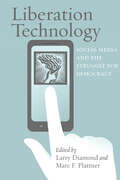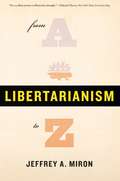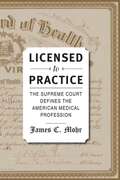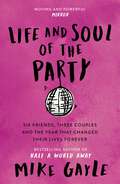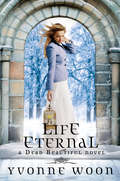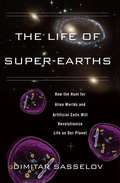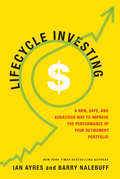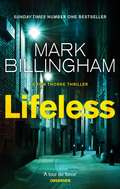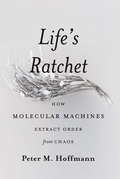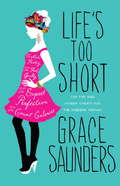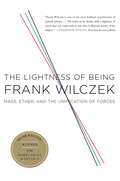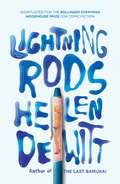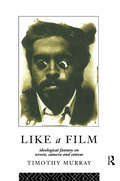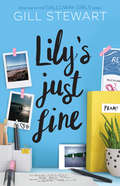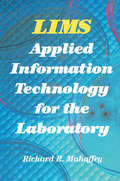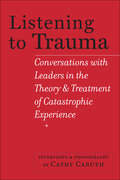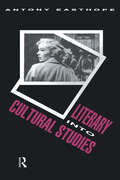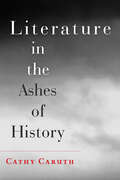- Table View
- List View
Liberation Technology: Social Media and the Struggle for Democracy (A Journal of Democracy Book)
by Larry Diamond Marc F. PlattnerThe revolutions sweeping the Middle East provide dramatic evidence of the role that technology plays in mobilizing citizen protest and upending seemingly invulnerable authoritarian regimes. A grainy cell phone video of a Tunisian street vendor’s self-immolation helped spark the massive protests that toppled longtime ruler Zine El Abidine Ben Ali, and Egypt’s "Facebook revolution" forced the ruling regime out of power and into exile. While such "liberation technology" has been instrumental in freeing Egypt and Tunisia, other cases—such as China and Iran—demonstrate that it can be deployed just as effectively by authoritarian regimes seeking to control the Internet, stifle protest, and target dissenters. This two-sided dynamic has set off an intense technological race between "netizens" demanding freedom and authoritarians determined to retain their grip on power.Liberation Technology brings together cutting-edge scholarship from scholars and practitioners at the forefront of this burgeoning field of study. An introductory section defines the debate with a foundational piece on liberation technology and is then followed by essays discussing the popular dichotomy of "liberation" versus "control" with regard to the Internet and the sociopolitical dimensions of such controls. Additional chapters delve into the cases of individual countries: China, Egypt, Iran, and Tunisia.This book also includes in-depth analysis of specific technologies such as Ushahidi—a platform developed to document human-rights abuses in the wake of Kenya’s 2007 elections—and alkasir—a tool that has been used widely throughout the Middle East to circumvent cyber-censorship.Liberation Technology will prove an essential resource for all students seeking to understand the intersection of information and communications technology and the global struggle for democracy.Contributors: Walid Al-Saqaf, Daniel Calingaert, Ronald Deibert, Larry Diamond, Elham Gheytanchi, Philip N. Howard, Muzammil M. Hussain, Rebecca MacKinnon, Patrick Meier, Evgeny Morozov, Xiao Qiang, Rafal Rohozinski, Mehdi Yahyanejad
Libertarianism, from A to Z
by Jeffrey A. MironLibertarian principles seem basic enough—keep government out of boardrooms, bedrooms, and wallets, and let markets work the way they should. But what reasoning justifies those stances, and how can they be elucidated clearly and applied consistently? In Libertarianism, from A to Z, acclaimed Harvard economist Jeffrey Miron sets the record straight with a dictionary that takes the reader beyond the mere surface of libertarian thought to reveal the philosophy&’s underlying and compelling logic. Tackling subjects as diverse as prostitution and drugs, the financial crises and the government bailouts, the legality of abortion, and the War on Terror, Miron takes the reader on a tour of libertarian thought. He draws on consequentialist principles that balance the costs and benefits of any given government intervention, emphasizing personal liberty and free markets. Miron never flinches from following those principles to their logical and sometimes controversial ends. Along the way, readers get a charming and engaging lesson in how to think like a libertarian. Principled, surprising, and thought provoking, Libertarianism, from A to Z, has everything a bourgeoning libertarian—or any responsible citizen—needs to know.
Licensed to Practice: The Supreme Court Defines the American Medical Profession
by James C. MohrLicensed to Practice begins with an 1891 shooting in Wheeling, West Virginia, that left one doctor dead and another on trial for his life. Formerly close friends, the doctors had fallen out over the issue of medical licensing. Historian James C. Mohr calls the murder "a sorry personal consequence of the far larger and historically significant battle among West Virginia’s physicians over the future of their profession."Through most of the nineteenth century, anyone could call themselves a doctor and could practice medicine on whatever basis they wished. But an 1889 U.S. Supreme Court case, Dent v. West Virginia, effectively transformed medical practice from an unregulated occupation to a legally recognized profession. The political and legal battles that led up to the decision were unusually bitter—especially among physicians themselves—and the outcome was far from a foregone conclusion.So-called Regular physicians wanted to impose their own standards on the wide-open medical marketplace in which they and such non-Regulars as Thomsonians, Botanics, Hydropaths, Homeopaths, and Eclectics competed. The Regulars achieved their goal by persuading the state legislature to make it a crime for anyone to practice without a license from the Board of Health, which they controlled. When the high court approved that arrangement—despite constitutional challenges—the licensing precedents established in West Virginia became the bedrock on which the modern American medical structure was built. And those precedents would have profound implications. Thus does Dent, a little-known Supreme Court case, influence how Americans receive health care more than a hundred years after the fact.
Licensed to Practice: The Supreme Court Defines the American Medical Profession
by James C. MohrLicensed to Practice begins with an 1891 shooting in Wheeling, West Virginia, that left one doctor dead and another on trial for his life. Formerly close friends, the doctors had fallen out over the issue of medical licensing. Historian James C. Mohr calls the murder "a sorry personal consequence of the far larger and historically significant battle among West Virginia’s physicians over the future of their profession."Through most of the nineteenth century, anyone could call themselves a doctor and could practice medicine on whatever basis they wished. But an 1889 U.S. Supreme Court case, Dent v. West Virginia, effectively transformed medical practice from an unregulated occupation to a legally recognized profession. The political and legal battles that led up to the decision were unusually bitter—especially among physicians themselves—and the outcome was far from a foregone conclusion.So-called Regular physicians wanted to impose their own standards on the wide-open medical marketplace in which they and such non-Regulars as Thomsonians, Botanics, Hydropaths, Homeopaths, and Eclectics competed. The Regulars achieved their goal by persuading the state legislature to make it a crime for anyone to practice without a license from the Board of Health, which they controlled. When the high court approved that arrangement—despite constitutional challenges—the licensing precedents established in West Virginia became the bedrock on which the modern American medical structure was built. And those precedents would have profound implications. Thus does Dent, a little-known Supreme Court case, influence how Americans receive health care more than a hundred years after the fact.
The Life: A dark suspense thriller of crime and corruption (Jack Howard Ser.)
by Martina ColeWhen it's in your blood, there's no other way.THE LIFE by the 'undisputed queen of crime writing' (Guardian) and Sunday Times No.1 bestseller Martina Cole is an unflinching novel that exposes a world that many would rather ignore...The Baileys are born into the Life.Brothers Daniel and Peter rule London's East End with threats and violence. Only a fool would cross them, but there are always those in the shadows who will try.And when their enemies strike, every Bailey pays the price. But none more so than Daniel's only daughter, Tania. The Life is in her blood, and now it's her weapon for revenge.For more novels that will take you deep into the dark and dangerous criminal underworld, check out Martina Cole's THE GRAFT, THE BUSINESS and REVENGE
Life and Soul of the Party
by Mike GayleA brilliant romantic comedy about a year in the lives of three couples from number one bestselling author Mike Gayle.Meet Melissa and Paul: Five years after they split up he's still looking for love in all the wrong places while she wants the one thing she can't have: Paul.Meet Chris and Vicky: They're so in tune they even brush their teeth in time with each other. So what is Chris doing risking it all for a meaningless affair?Meet Cooper and Laura: He wants to settle down, she wants to take a grown-up gap year but can their relationship really survive a year apart?Set across a year of leaving dos, birthday parties and anniversary celebrations, Life and Soul of the Party is a warm, funny and moving tale celebrating love, life and those special moments we've all spent in the kitchen at parties.
Life Eternal (A Dead Beautiful Novel #2)
by Yvonne WoonThe dark, romantic sequel to Dead Beautiful from Yvonne Woon.Renée Winters has changed. When she looks in the mirror, a beautiful girl with an older, sadder face stares back. Her condition has doctors mystified, but Renée can never reveal the truth: she died last May, and was brought back to life by the kiss of her Undead soul mate, Dante Berlin. Now, her separation from Dante becomes almost unbearable. His second life is close to an end, and each passing day means one less that she will spend with the boy who shares her soul. Just when Renée has almost given up hope, she learns of the Nine Sisters—brilliant scholars who, according to legend, found a way to cheat death. She can&’t shake the feeling that they are somehow connected to her dreams, strange visions that hint at a discovery so powerful, and so dangerous, that some will stop at nothing to protect it. Renée thought she knew the truth about life and death. But there is a secret woven through history that holds the only hope for Dante and Renée. Unless they find answers soon, their time together is doomed to be cut short....
The Life of Super-Earths: How the Hunt for Alien Worlds and Artificial Cells Will Revolutionize Life on Our Planet
by Dimitar SasselovIn 1543, Nicolaus Copernicus fomented a revolution when he debunked the geocentric view of the universe, proving instead that our planet wasn&’t central to the universe. Almost five hundred years later, the revolution he set in motion is nearly complete. Just as earth is not the center of things, the life on it, it appears, is not unique to the planet. Or is it? The Life of Super-Earths is a breathtaking tour of current efforts to answer the age-old question: Are we alone in the universe? Astronomer Dimitar Sasselov, the founding director of Harvard University&’s Origins of Life Initiative, takes us on a fast-paced hunt for habitable planets and alien life forms. He shows how the search for &“super-Earths&”—rocky planets like our own that orbit other stars—may provide the key to answering essential questions about the origins of life here and elsewhere. That is, if we don&’t find the answers to those questions here first. As Sasselov and other astronomers have uncovered planets with mixes of elements different from our own, chemists have begun working out the heretofore unseen biochemistries that those planets could support. That knowledge is feeding directly into synthetic biology—the effort to build wholly novel forms of life—making it likely that we will first discover truly &“alien&” life forms in an earthly lab, rather than on a remote planet thousands of light years away. Sasselov tells the gripping story of a moment of unprecedented potential—a convergence of pioneering efforts in astronomy and biology to peer into the unknown. The Life of Super-Earths offers nothing short of a transformation in our understanding of life and its place in the cosmos.
Lifecycle Investing: A New, Safe, and Audacious Way to Improve the Performance of Your Retirement Portfolio
by Ian Ayres Barry NalebuffDiversification provides a well-known way of getting something close to a free lunch: by spreading money across different kinds of investments, investors can earn the same return with lower risk (or a much higher return for the same amount of risk). This strategy, introduced nearly fifty years ago, led to such strategies as index funds. What if we were all missing out on another free lunch that&’s right under our noses? In Lifecycle Investing, Barry Nalebuff and Ian Ayres—two of the most innovative thinkers in business, law, and economics—have developed tools that will allow nearly any investor to diversify their portfolios over time. By using leveraging when young—a controversial idea that sparked hate mail when the authors first floated it in the pages of Forbes—investors of all stripes, from those just starting to plan to those getting ready to retire, can substantially reduce overall risk while improving their returns. In Lifecycle Investing, readers will learnHow to figure out the level of exposure and leverage that&’s right for youHow the Lifecycle Investing strategy would have performed in the historical marketWhy it will work even if everyone does itWhen not to adopt the Lifecycle Investing strategy Clearly written and backed by rigorous research, Lifecycle Investing presents a simple but radical idea that will shake up how we think about retirement investing even as it provides a healthier nest egg in a nicely feathered nest.
Lifeless (Tom Thorne Novels #5)
by Mark BillinghamA SERIES OF KILLINGSThree men, sleeping rough on London's mean streets, have been found brutally murdered - each victim kicked to death and found with a £20 note pinned to his chest. But were they killed at random, or were they targeted for a reason?A DEADLY MISSIONTom Thorne is posted to the same streets - working undercover, disguised as a homeless man. In a harsh and harrowing underworld, Thorne discovers the horrifying link between the homeless victims and the perpetrators of a fifteen-year-old atrocity. A RUTHLESS ENEMYThose who know are keeping quiet. But the word on these streets is that the killer is a cop...
Lifelines from Our Past
by L. S. StavrianosThis book offers an extraordinary interpretation of world history, from the paleolithic era to the present. Renowned historian L.S. Stavrianos conceptualizes human history into three categories: kinship societies, tributary societies, and capitalist societies. In each, he discerns and studies four "life-line" issues - ecology, gender relations, social relations, and war - that encompass the broadest areas of human experience. The revised edition projects forward to the twenty-first century, offering the author's views on possible future scenarios involving the same lifeline issues.
Life's Ratchet: How Molecular Machines Extract Order from Chaos
by Peter M. HoffmannThe cells in our bodies consist of molecules, made up of the same carbon, oxygen, and hydrogen atoms found in air and rocks. But molecules, such as water and sugar, are not alive. So how do our cells—assemblies of otherwise &“dead&” molecules—come to life, and together constitute a living being? In Life&’s Ratchet, physicist Peter M. Hoffmann locates the answer to this age-old question at the nanoscale. The complex molecules of our cells can rightfully be called &“molecular machines,&” or &“nanobots&”; these machines, unlike any other, work autonomously to create order out of chaos. Tiny electrical motors turn electrical voltage into motion, tiny factories custom-build other molecular machines, and mechanical machines twist, untwist, separate and package strands of DNA. The cell is like a city—an unfathomable, complex collection of molecular worker bees working together to create something greater than themselves. Life, Hoffman argues, emerges from the random motions of atoms filtered through the sophisticated structures of our evolved machinery. We are essentially giant assemblies of interacting nanoscale machines; machines more amazing than can be found in any science fiction novel. Incredibly, the molecular machines in our cells function without a mysterious &“life force,&” nor do they violate any natural laws. Scientists can now prove that life is not supernatural, and that it can be fully understood in the context of science. Part history, part cutting-edge science, part philosophy, Life&’s Ratchet takes us from ancient Greece to the laboratories of modern nanotechnology to tell the story of our quest for the machinery of life.
Life's Ratchet: How Molecular Machines Extract Order from Chaos
by Peter M HoffmannLife is an enduring mystery. Yet, science tells us that living beings are merely sophisticated structures of lifeless molecules. If this view is correct, where do the seemingly purposeful motions of cells and organisms originate? In Life's Ratchet, physicist Peter M. Hoffmann locates the answer to this age-old question at the nanoscale. Below the calm, ordered exterior of a living organism lies microscopic chaos, or what Hoffmann calls the molecular storm -- specialized molecules immersed in a whirlwind of colliding water molecules. Our cells are filled with molecular machines, which, like tiny ratchets, transform random motion into ordered activity, and create the "purpose" that is the hallmark of life. Tiny electrical motors turn electrical voltage into motion, nanoscale factories custom-build other molecular machines, and mechanical machines twist, untwist, separate and package strands of DNA. The cell is like a city -- an unfathomable, complex collection of molecular workers working together to create something greater than themselves. Life, Hoffman argues, emerges from the random motions of atoms filtered through these sophisticated structures of our evolved machinery. We are agglomerations of interacting nanoscale machines more amazing than anything in science fiction. Rather than relying on some mysterious "life force" to drive them -- as people believed for centuries -- life's ratchets harness instead the second law of thermodynamics and the disorder of the molecular storm. Grounded in Hoffmann's own cutting-edge research, Life's Ratchet reveals the incredible findings of modern nanotechnology to tell the story of how the noisy world of atoms gives rise to life itself.
Life's Too Short: Top tips and insider cheats for the modern girl
by Grace SaundersBills, boyfriends, Bikram yoga... nobody said life was easy. But you can make it a whole lot less stressful with this ingenious guide to modern life. In LIFE'S TOO SHORT, Grace Saunders shares her shortcuts to success at work, at home and at play, along with terrific tips from those in the know. Whether you're a single lady, a committed career woman or a mega-busy mum, this book should be your bible. Need a quick fix for... How to plan a wedding without becoming Bridezilla. How to find jeans that don't give you a massive muffin-top. How to move house without having a nervous breakdown. How to ease that agonising shoe spending guilt? Sit back and relax. LIFE'S TOO SHORT is just what you've been looking for.
Light (S.F. MASTERWORKS #1)
by M. John HarrisonOn the barren surface of an asteroid, located deep in the galaxy beneath the unbearable light of the Kefahuchi Tract, lie three objects: an abandoned spacecraft, a pair of bone dice covered with strange symbols, and a human skeleton. What they are and what they mean are the mysteries explored and unwrapped in LIGHT, M. John Harrison's triumphant novel.
The Lightness of Being: Mass, Ether, and the Unification of Forces
by Frank WilczekA Nobel-prize winning physicist takes on the essential question: what are we made of?Our understanding of nature's deepest reality has changed radically, but almost without our noticing, over the past twenty-five years. Transcending the clash of older ideas about matter and space, acclaimed physicist Frank Wilczek explains a remarkable new discovery: matter is built from almost weightless units, and pure energy is the ultimate source of mass. He calls it "The Lightness of Being." Space is no mere container, empty and passive. It is a dynamic Grid-a modern ether- and its spontaneous activity creates and destroys particles. This new understanding of mass explains the puzzling feebleness of gravity, and a gorgeous unification of all the forces comes sharply into focus.The Lightness of Being is the first book to explore the implications of these revolutionary ideas about mass, energy, and the nature of "empty space." In it, Wilczek masterfully presents new perspectives on our incredible universe and envisions a new golden age of fundamental physics.
Lightning Rods (G - Reference, Information And Interdisciplinary Subjects Ser.)
by Helen DeWittAll I want is to be a success. That's all I ask.' Failing salesman Joe has a dream - or rather an outrageous fantasy. Because holed up in his trailer Joe comes up with a jaw-dropping plan that will stamp out sexual harassment in the workplace and make his fortune. Win-win? As he turns his life around, Lightning Rods takes us to the very top of corporate America.
Like a Film: Ideological Fantasy on Screen, Camera and Canvas
by Timothy MurrayIn this stimulating collection of theoretical writings on film, photography, and art, Timothy Murray examines relations between artistic practice, sexual and racial politics, theory and cultural studies. Like a Film investigates how the cinematic apparatus has invaded the theory of culture, suggesting that the many destabilising traumas of our culture remain accessible to us because they are structured so much like film. The book analyses the impact of cinematic perceptions and productions on awide array of cultural practices: from the Renassance works of Shakespeare and Caravaggio to modern sexual and political fantasy; and the theoretical work of Lyotard, Torok, Barthes, Ropars-Wuilleumier, Zizek, Silverman and Laplanche.Like A Film responds to current multicultural debates over the value of theory and the aim of artistic practice.
Lily's Just Fine (Galloway Girls #1)
by Gill StewartLily couldn’t have planned life better herself. She lives in the best house in town and she’s dating the most popular boy in school. Everything else she can fix. Mum’s apathy? On it! The stuffy gala committee? Watch this space! Tom has enough on his plate without trying to drag Newton St Cuthbert into the 21st Century. His sister is sick and there’s nothing anyone can do. Not doctors, not his parents, and certainly not Lily Hildebrand. About the Galloway Girls series:Set in the west coast of Scotland, Galloway Girls is a contemporary YA series with a touch of romance. Newfound friendships and unexpected summer romances arise as four teens plan their futures and face adulthood. Summery and light-hearted while dealing with relatable teen issues such as family relationships and mental wellbeing, Galloway Girls is perfect for girls 14+ and fans of Lucy Powrie, Stephanie Perkins and Jenny Han.
LIMS: Applied Information Technology for the Laboratory
by Richard MahaffeyComputing and information management technologies touch our lives in the environments where we live, play and, work. High tech is becoming the standard. Those of use who work in a laboratory environment are faced with an obvious challenge. How do we best apply these technol ogies to make money for our companies? The first level of deliverable benefits is achieved through task automation. The second level is ob tained by integrating the individual islands of automation. The third, or top level, of benefits is related to applying intelligence to computing applications. The use of computing technology, at level one, to automate lab pro cedures, methods, and instruments has been profitable for many years. We can easily find yearly returns in the range of 10-50% for investments at this level. For level two, the integration of some applications has evolved and has led to data management systems and local area net working in the lab environment. Investment paybacks at level two are substantially higher, in the range of 200-400%. Examples of applications at the top level, that of intelligent systems and applications, are few and far between. And what about the payback for investments at this level? With such limited experience at level three, we can only estimate the benefits. But again, they appear to be much higher, in the range of 2000- 4000%.
Listening to Trauma: Conversations with Leaders in the Theory and Treatment of Catastrophic Experience
by Cathy CaruthThis new collection from Cathy Caruth features interviews with a diverse group of leaders in the theorization of, and response to, traumatic experience in the twentieth and twenty-first centuries. Crossing the boundaries of discipline and profession, Caruth’s subjects include literary theorists and critics, psychoanalysts, psychiatrists, psychologists, political activists, filmmakers, public intellectuals, institutional leaders, and researchers. Exploring the intertwining of the intellectual and personal dimensions of experience, each interview is accompanied by Caruth's intimate photographic portrait of its subject. Caruth chose her subjects because of their impact on her thinking as well as their significant role as witnesses to the collective and cultural significance of trauma. The individuals profiled here are innovators in the theory of trauma (Part I), in the clinical, activist, or testimonial interventions in trauma (Part II), or in the creation or modification of institutions that provide therapeutic, artistic, or legal responses to traumatic events (Part III). Two of the interviews first appeared in Caruth's landmark 1995 work, Trauma: Explorations in Memory. The rest were conducted between 2011 and 2013 after the field of trauma studies expanded significantly. Representing both the foundation of trauma research and cutting-edge approaches to the topic, this collection will be useful to practitioners with an interest in post-traumatic stress disorder as well as scholars exploring the multiple dimensions of profound human experience.A portion of the proceeds from sales of this book will go to the Grady Nia Project for abused, suicidal, and low-income African American women.
Listening to Trauma: Conversations with Leaders in the Theory and Treatment of Catastrophic Experience
by Cathy CaruthThis new collection from Cathy Caruth features interviews with a diverse group of leaders in the theorization of, and response to, traumatic experience in the twentieth and twenty-first centuries. Crossing the boundaries of discipline and profession, Caruth’s subjects include literary theorists and critics, psychoanalysts, psychiatrists, psychologists, political activists, filmmakers, public intellectuals, institutional leaders, and researchers. Exploring the intertwining of the intellectual and personal dimensions of experience, each interview is accompanied by Caruth's intimate photographic portrait of its subject. Caruth chose her subjects because of their impact on her thinking as well as their significant role as witnesses to the collective and cultural significance of trauma. The individuals profiled here are innovators in the theory of trauma (Part I), in the clinical, activist, or testimonial interventions in trauma (Part II), or in the creation or modification of institutions that provide therapeutic, artistic, or legal responses to traumatic events (Part III). Two of the interviews first appeared in Caruth's landmark 1995 work, Trauma: Explorations in Memory. The rest were conducted between 2011 and 2013 after the field of trauma studies expanded significantly. Representing both the foundation of trauma research and cutting-edge approaches to the topic, this collection will be useful to practitioners with an interest in post-traumatic stress disorder as well as scholars exploring the multiple dimensions of profound human experience.A portion of the proceeds from sales of this book will go to the Grady Nia Project for abused, suicidal, and low-income African American women.
Literary into Cultural Studies
by Antony EasthopeFirst published in 1991. Routledge is an imprint of Taylor & Francis, an informa company.
Literature in the Ashes of History
by Cathy CaruthCathy Caruth juxtaposes the writings of psychoanalysts, literary and political theorists, and literary authors who write in a century faced by a new kind of history, one that is made up of events that seem to undo, rather than produce, their own remembrance. At the heart of each chapter is the enigma of a history that, in its very unfolding, seems to be slipping away before our grasp. What does it mean for history to disappear? And what does it mean to speak of a history that disappears? These questions, Caruth suggests, lie at the center of the psychoanalytic texts that frame this book, as well as the haunting stories and theoretical arguments that resonate with each other in profound and surprising ways. In the writings of Honoré de Balzac, Hannah Arendt, Ariel Dorfman, Wilhelm Jensen, Sigmund Freud, and Jacques Derrida, we encounter, across different stakes and different languages, a variety of narratives that bear witness not simply to the past but also to the pasts we have not known and that repeatedly return us to a future that remains beyond imagination.These stories of trauma cannot be limited to the catastrophes they name, and the theory of catastrophic history may ultimately be written in a language that already lingers in a time that comes to us from the other side of the disaster.
Literature in the Ashes of History
by Cathy CaruthCathy Caruth juxtaposes the writings of psychoanalysts, literary and political theorists, and literary authors who write in a century faced by a new kind of history, one that is made up of events that seem to undo, rather than produce, their own remembrance. At the heart of each chapter is the enigma of a history that, in its very unfolding, seems to be slipping away before our grasp. What does it mean for history to disappear? And what does it mean to speak of a history that disappears? These questions, Caruth suggests, lie at the center of the psychoanalytic texts that frame this book, as well as the haunting stories and theoretical arguments that resonate with each other in profound and surprising ways. In the writings of Honoré de Balzac, Hannah Arendt, Ariel Dorfman, Wilhelm Jensen, Sigmund Freud, and Jacques Derrida, we encounter, across different stakes and different languages, a variety of narratives that bear witness not simply to the past but also to the pasts we have not known and that repeatedly return us to a future that remains beyond imagination.These stories of trauma cannot be limited to the catastrophes they name, and the theory of catastrophic history may ultimately be written in a language that already lingers in a time that comes to us from the other side of the disaster.
